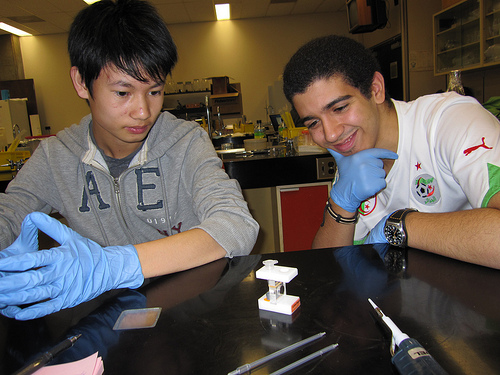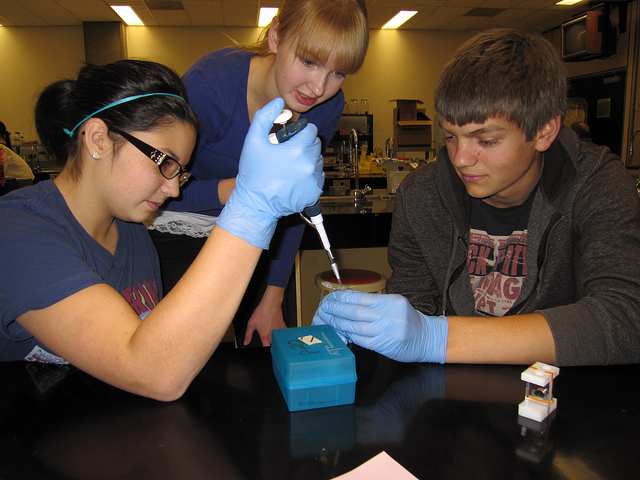Team:Alberta/human practices/HighSchool
From 2010.igem.org
| (3 intermediate revisions not shown) | |||
| Line 1: | Line 1: | ||
{{Team:Alberta/Head}} | {{Team:Alberta/Head}} | ||
| - | {{Team:Alberta/navbar| | + | {{Team:Alberta/navbar|practices=selected}} |
{{Team:Alberta/beginLeftSideBar|toc=NO}} | {{Team:Alberta/beginLeftSideBar|toc=NO}} | ||
| + | |||
| + | |||
| + | |||
| + | |||
| + | |||
| + | |||
Latest revision as of 16:43, 27 October 2010
Real World Trials
Currently, the experiments that can be done at a high school level are greatly limited by a tight budget, a lack of appropriate equipment and space, as well as scheduling issues. Consequently, high school biology experiments have traditionally been centered around dissections. The current experiments neglect many exciting fields in biology, such as synthetic biology. The GENOMIKON kit attempts to change this by being cost-effective, relevant to the high school curriculum, and not requiring any expensive reagents or equipment. Not to mention, our experiments fit well within the average high school class period. In order to prove the applicability of the GENOMIKON kit, we arranged for five high school students to test it out in our laboratory on Oct. 24, 2010. They built a four-piece DNA construct (AB KanR, BA ori, AB RFP, and cap) using our kit and Biobyte 2.0 assembly protocol in just under two hours. This construct was then transformed into E. coli . The following day, there were red colonies present on kanamycin plates, demonstrating that their assembly was indeed successful! The students greatly enjoyed this experiment and even gave us some very valuable feedback. Here's what the students had to say when asked about what they knew about E. coli :
- 'It's in meat' - Jillian Underwood, 15
- 'It can live in our intestines' - Aymen Saidane, 17
Not surprisingly, their comments reflect the general public opinions of E. coli . In order to address any misconceptions, the students were educated on the difference between pathogenic E. coli strains (0157:H7), and the harmless strain that we are using in our kit (DH5α). The students then stated that they were not at all apprehensive about working with the bacteria or DNA used in the experiment.
One of our team members taught the students simple theory, including general information about DNA, our assembly method and the specific BioBytes that they were using. Following this, they were led through the assembly and were also taught how to use the GENOMIKON website. The students agreed that the plasmid designer feature was "cool" and that the glossary and encyclopedia were very useful. Interestingly, Aymen Saidane (grade 12), said that he had already learned about molecular biology in his Biology 30 course in high school. However, he had not had the chance to apply his knowledge. The only experiment he had done was 'cut paper DNA sequences with scissors, to represent restriction enzymes, and then matched our pieces with classmates.' This led us to conclude that the GENOMIKON kit is ideal for complementing a grade 12 curriculum.
Here is some more feedback from the students:
- 'The magnetic beads are cool' - Jill Hacking, 15
- 'The plastic pipettes were easy to use and kind of fun' - Bryce Stewart, 15
- They didn't mind the fact that they didn't get to do the transformation since the DNA assembly was the more interesting part.
- 'I don't think I could explain this to my parents, because they wouldn't get it, but if I explained it to a friend, he would understand.' - Alan Ho, 16
- 'I learned the theory already, but I got to apply it today.' - Aymen Saidane, 17
This is just the beginning of GENOMIKON in the classroom. In future trials, students can build even more complicated constructs and even design their own experiments. GENOMIKON doubles as an educational tool and as another method to clear up any misconceptions that the public may have about synthetic biology. It will educate students, parents and teachers, first hand, on the many ways synthetic biology can be used to benefit society.
 "
"


